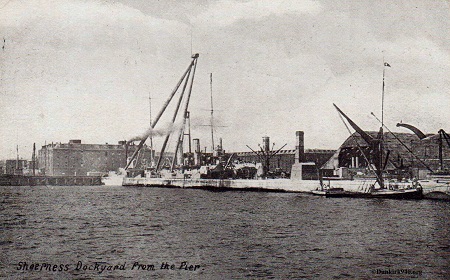
Sheerness is a port on the north-west side of the Isle of Sheppey. In 1940 it was a Royal Naval Dockyard and operated a Royal Navy small vessels pool. The role of the port in Operation Dynamo is largely overlooked in post-war accounts of the evacuation and personal accounts are scarce. From the 27th May to the 4th June 1940, Sheerness was a hive of activity. Operations were controlled by Acting-Commodore Taylor and his small staff based at Admiralty House, which overlooked the harbour basin.
The dockyard possessed a boat store which held un-issued naval launches, cutters, gigs and whalers. Over the period 27th – 31st May, these small vessels were taken out of store, checked over, floated in the harbour and loaded with oars and other gear. They were then towed by steam tug to Dunkirk to assist in the evacuation from the beaches.
As the call went out for the requisition of small boats to assist in the evacuation, by virtue of its geographical position, Sheerness was the natural choice as a collection point for those "little ships" collected from the Thames, Medway and Essex coasts, prior to despatch to Ramsgate and ultimately, Dunkirk. In addition, Royal Navy engineers from Sheerness and those drafted in from Chatham, worked to get the engines on these small craft serviceable for their arduous journey. Fuel tanks were topped off and what equipment and stores were available were loaded. Acting-Commodore Taylor had the authority to collect and service civilian small craft and sign up and pay civilian crews (civilians were required to sign up for one month's service in the RN before going to Dunkirk).
A number of the older Royal Navy vessels involved in the evacuation were still coal-fired (nicknamed the "smokey Joes"). Sheerness had the coaling facilities to service such ships. One such vessel was the minesweeper HMS Albury. She rescued 1,800 men from the beaches and would land those evacuated at Margate, before returning to Sheerness to replenish her coal and ammunition stocks.
Twenty-two ships are recorded as landing 8,465 troops at Sheerness. Buses were used to transport the troops to Sheerness-on-Sea railway station, although some groups were marched there from the dockyard complex. Sheerness was allocated 21 trains for the evacuation.

Photograph of Sheerness station taken in the 1950's
The film "Dunkirk" released in 1958, starring the late John Mills, used the harbour basin at Sheerness and the adjacent Royal Naval shore establishment, HMS Wildfire, for several scenes. The role of the Dockyard and the people of the Isle of Sheppey in the evacuation is today commemorated by a plaque which is affixed to the Sheerness War Memorial.
To read the personal account of Vera Wilson, please click here.
To read the personal account of Lance-Corporal Charles Crisp, please click here.
Back
To read the personal account of Lance-Corporal Charles Crisp, please click here.
Back
